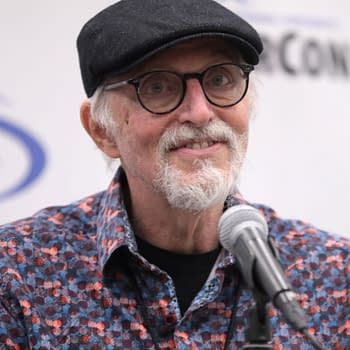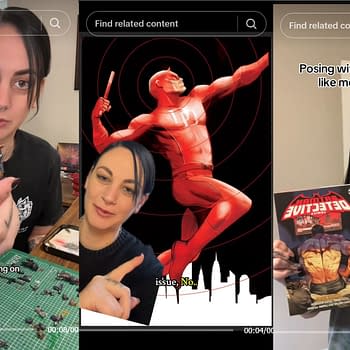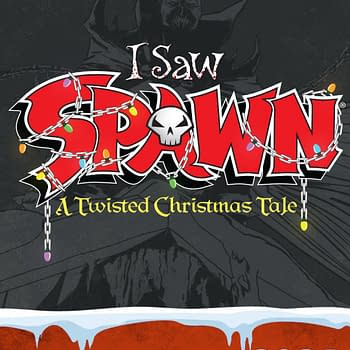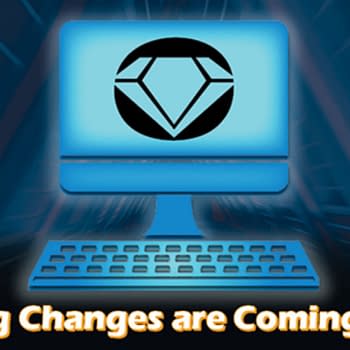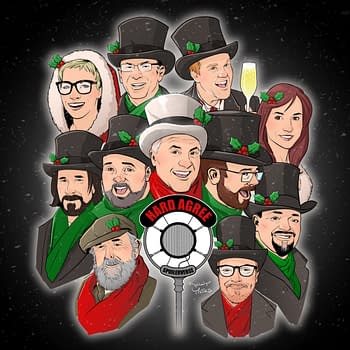Posted in: Comics, Recent Updates | Tagged: action, adventure, charlie adlard, Comics, Elsa Charretier, entertainment, idw, kickstarter, LGBTQ comics, Pierrick Colinet, same-sex couples, sci-fi, The Infinite Loop
IDW's The Infinite Loop Dares You Not To Care – Talking With Elsa Charretier And Pierrick Colinet
Yep, there's a comic on the horizon that's going to make you care about it and what it says. It's also going to entertain you, allure you with its beauty, and leave you with a sense that comics really are moving forward in themes, scope, and skill. The Infinite Loop has a strange history as a comic, but one that may be familiar to indie creators. It started with a fairly wild dream to create a comic, though the artist had only recently started drawing, it developed through a chance meeting and some kind encouragement and advice from Charlie Adlard of The Walking Dead, it succeeded at Kickstarter, and now it has been picked up by IDW. If you read between the lines, you'll guess that a lot of hard work paved the way between all these points of development, including the team of Elsa Charretier and Pierrick Colinet using some of their Kickstarter money to fly from France to New York Comic Con just to personally pitch their book to publishers.
They've achieved their dream of breaking into the American comics market with The Infinite Loop, but the meaning behind the comic is just as important to the duo. This is a love story that transcends time and space, role and social supposition, and for the creators of the comic, this is about presenting same-sex relationships in a way that will hopefully break down the bastions of resistance that keep hate alive in the 21st century. This 6 issue mini-series is arriving April 22nd and Elsa and Pierrick join us here today for a wide-ranging discussion of the history and success of The Infinite Loop so far, and what it means to them.

Elsa Charretier: We met Charlie about 3 years ago, just before we took the big step of making comic books full time. We didn't know much at the time about how this whole industry worked, and I think in a way our naivety helped us. We met him during a signing he did in an old abbey, in the countryside, where the publisher had re-created the Walking Dead "conditions". There were dozens of cosplayers dressed up as zombies, crawling around the whole property. They set the mood quite well… Anyway, at the end of the signing, Charlie came to us and agreed to look at our pages. We had just 4 of them, and it was… hum… well let's say I had started drawing just a few weeks before. Despite the poor quality of it, he spent 45 minutes with us, explaining how we could get better, what we could focus on. It was a huge help for beginners like us, but he didn't stop there. He followed our evolution, kept on giving us advice when we needed, guided us on the right path when we were lost. When you think everything you do is worth nothing and then Charlie Adlard says he thinks it's good, you don't think twice, you keep going!
He gave us strength right from the beginning, and I will never be able to thank him enough for it.
Pierrick Colinet: Charlie rarely comments on the writing part of our projects. As an artist, he feels more qualified to give advice on the sequential part. However, I always keep his supportive words in mind. Breaking into comics is hard, and gets harder every time one of your books doesn't get picked up by a publisher. With every failure, he was there to encourage us not to give up, and to keep going until it'd work. Having someone who believes this much in you makes a huge difference. And when that person is Charlie Adlard, well, its makes you want to work even more, even harder.
HMS: Were you surprised at how quickly the project crowdfunded?
PC: We were more than surprised! We just couldn't have imagined the project would get funded in less than a week. To be honest, we had doubts we'd reach our goal at all. We had even put money aside, just in case we'd need to back our own project!
In the end, we got over $14,000. Beyond the financial aspect that allowed us to create this book in the best possible conditions, the backers' (and non backers') support gave us a fantastic energy that motivated us throughout all these months. It's a very lonely process, and the idea of hundreds of people having your back gives you new perspectives.
EC: Well, everything Pierrick said! The whole campaign was surreal. We discovered that there were lots of people willing to help us, spreading the word, and overall being very supportive. We know that none of this could have happened without this first huge push.
HMS: What are your feelings about how same-sex couples are perceived in modern society at this time and why did you choose to showcase a same-sex couple as a major focus of the plot and characterization of the book?
PC: More and more, I have the feeling that two sides are facing each other. The side of those who think same-sex couples' rights are obvious, and the side of those who fight relentlessly against it. And what worries me, is that that latter category makes a lot more noise, despite being a lot fewer in number. Among others, I think of Ted Cruz and his recent anti-gay marriage bill. People rally less in favor of freedom, because we tend to think freedoms are established for good and not in danger.
I chose these characters because I feel same-sex rights are the fight of our time. Every era in History has had its martyred community, as if it was integral part of humanity's way of being. That's precisely what The Infinite Loop is all about. Yesterday, African-Americans were targeted, today, gays are, and tomorrow, another minority will be. These two women represent the fact that freedom is never fully acquired, but must be fought for, together. It takes centuries to acquire it, and just a few seconds to go backwards.
EC: I guess I'm a little pissed that it's something we still need to talk about, that same-sex couples still need to stand up for their rights. The remarks we keep hearing against them are revolting and the fight against homophobia is everybody's business, gay and straight people. I'm often asked why I feel so concerned by it: am I gay myself? And that's a huge part of the problem. Why does it feel normal to everyone to care about hunger in Africa, and when it comes to LGBT causes, you have to be somewhat personally concerned about it?
You don't have to be gay to feel the need to raise attention against an injustice, against a right that is being flooded: the right to love freely and not be judged for it.
HMS: What do you feel is universal about The Infinite Loop and might appeal to all readers?
EC: I think the two main themes, love and the fight for our basic right to love, can resonate in everyone's heart. Love echoes in all of us. At a certain point in our lives, we all had to fight for love, whether it was to find it, or to keep it.
That's one of the things that made me want to work on this book so bad. Would I do this myself? Would I throw my heart and soul into a fight that might endanger my own life, and my family's lives? Honestly, I'd like to say yes, but I don't know. And I'm probably not the only one to wonder. Drawing this story made me realize that supporting the people that actually act is already a step… at least I hope so!
And most importantly, we tried to keep the whole book fun. Delivering an important message wasn't going to keep us from making a book full of adventure, action, and loaded with sci-fi references.
PC: As I said earlier, everybody feels concerned about freedom. And even more so in the US I think. Look at your Declaration of Independence: "All men are created equal, that they are endowed by their Creator with certain unalienable Rights, that among these are Life, Liberty and the pursuit of Happiness".
The Infinite Loop puts the readers alongside these two women, who are fighting so that this sentence can also apply to them.

EC: The Infinite Loop has been a real game changer for me, in terms of art style. Before working on it, my style was more realistic, but it felt wrong. I was never really comfortable with it. I was fascinated by animation, cartoony styles, but I was a bit scared to try it myself. It feels a bit stupid to admit it, but I was scared that it'd prevent me from working on a lot of mainstream titles.
In the end, Pierrick and Charlie encouraged me to trust my instincts, and to do what I liked! The first pages I did for The Infinite Loop campaign were in fact the first pages I did with this new style. And it was a revelation. I would enjoy working a lot more, and it hugely impacted my storytelling. I stopped drawing and started expressing myself.
PC: When Elsa decided to switch to a more cartoony style, I knew she'd do great. She has this ability to always give the best of herself and to learn really REALLY fast. What I wasn't expecting though, was how her storytelling would evolve. Every page is beautiful, sexy, smart and with a formidable fluidity. I feel so lucky to have her on TIL.
HMS: Does it feel strange to be breaking into the American market with this book? Do you think there are any difficulties in making sure the book translates across cultural differences?
PC: Not at all! From the moment I felt the urge to write comic books, I knew that working in the American market would be a lot more fulfilling. In France we mostly have hardcover books, big in format, but short in pages. I always got frustrated by this way of telling stories, and the monthly serialized comic format works a lot better for me. And even for my first book, which was released as a hardcover, I wrote the story in 22 pages chapters, as if they first came out in singles.
I can't help it, I grew up watching American TV shows, and American movies, before taking an interest in US comic books. Culturally speaking, I'm American, and I hope the readers will see in The Infinite Loop my declaration of love to American pop culture.

PC: The Infinite Loop is a science fiction comic book that tells us about true love, the unlikelihood of ever finding it, and the struggle for living it in the open despite a society that rejects it and considers it an anomaly. Ano is a girl born from a time paradox accident that Teddy, a time paradox hunter, is supposed to eliminate, but what if this beautiful creature were in fact her true love?
I really tried to put the reader at the heart of the book. Make them both a witness AND a participant. From issue 1, the reader will find themselves alongside Teddy and will be involved with everything that happens to her. They'll have to make important choices, and try to react the best possible way when an unexpected obstacle comes up. Without spoiling too much, just know that it involves a freaking T-Rex!
Elsa : I think the way Pierrick told this story is, in itself, very interesting and unique. He found lots of fun ways to keep the reader's attention, to give them the feeling that they were entering a little experience. That's, at least, how I saw it!
HMS: How did you come to publish The Infinite Loop with IDW? What are the benefits of working with IDW in your opinion?
Elsa : Well, that's a whole story ! From the beginning, our idea was to submit this book to an American publisher. That's what we had done with previous projects, but it never worked. So, we thought emailing was probably not enough, at least not for unknown artists that had never published a book in the US. We thought we might as well go there and meet them face to face!
The crowdfunding campaign was so successful that we had enough money to go to NYCC. And so, last October, we landed in New York City for the first time, completely blown away by the city and the size of the convention. I spent the whole 4 days running around (while Pierrick was keeping the table), talking to people, meeting editors, and showing the book around. It was a little marathon everyday, but it was fantastic. Nobody knew who we were, but in the end, the feedback was really good.
Then we went back home, and a few days later, we got an email from IDW!
Crowdfunding is quite the adventure. It's a fantastic tool but I think that most of the creators who have experienced it will agree in saying it's a huge amount of work. And by this I mean a huge amount of work in addition to the creation itself. Promotion, mock-ups, rewards, having to deal with the printing, all the backers, all the packages to send, it's all really time-consuming.
In addition to a much wider exposure, IDW is incredibly supportive. Although you deal with 200, 500 or even 1,000 backers when you crowd-fund a book, the process is pretty lonely. The IDW team never misses an opportunity to tell us we can lean on them if we need to; they are very warm and willful people, always eager to give advice. Working with them allows us a lot more time to actually create.

EC: I'd strongly recommend crowdfunding, for many reasons. The main one being that, if you cut production costs as much as you can and set up a reasonable goal, your chances of getting funded and to actually produce a book are pretty high! Submitting dozens of projects to editors doesn't always pay off and can really discourage you. Although it can get really hard, at least crowdfunding gives you the opportunity to actually work, and do what you like to do.
A career entirely based on crowdfunding seems pretty hard to conceive, both personally and financially. But it's been proven to be a fantastic springboard!
PC: There are two pieces of advice that helped me a lot. I think that without applying them, I probably would have never been published. Firstly, finish your projects. You can get so scared of failure when you're starting out that you can always find a good excuse to give up one project and throw yourself in another one. Finish them, and submit it to publishers. If you get a "no," then it's time to start another one :)
The second one was given to me by the great French editor, Thierry Mornet. He taught me to do one step after another, not to aim too high too soon. The first time I pitched TIL to editors, it was a 12 issues series that could eventually become an ongoing. Looking back, it was really naive of me, a publisher was never going to trust a beginner on that many issues. So I guess, start small, and show you're able to tell a story and meet deadlines.
HMS: Are you working on any other comic projects that you'd like to mention?
PC: Right now I'm working on the last issues of The Infinite Loop. That kind of story allows an infinite number of endings. I find a new one almost everyday. If it keeps going, I'll have to write a spin-off with all the alternate endings!
I'm also developing a plot with the awesome Drew Moss. Basically, it will be a horrific and poetic thriller, and from the first images I saw, it's going to be beautiful.
EC: As Pierrick mentioned, I'm about to start the last 3 issues on TIL. I'm really looking forward to it! After that, I'll be lucky enough to work with George RR Martin and Lisa Tutte on their graphic novel, Windhaven. It's a very ambitious project, with an incredible potential. I'm also very eager to start, although I'm a bit nervous, I won't have my sidekick by my side!
Make sure to watch out for The Infinite Loop when it arrives in shops in April from IDW. It is currently listed in Previews with the item code: FEB150348











